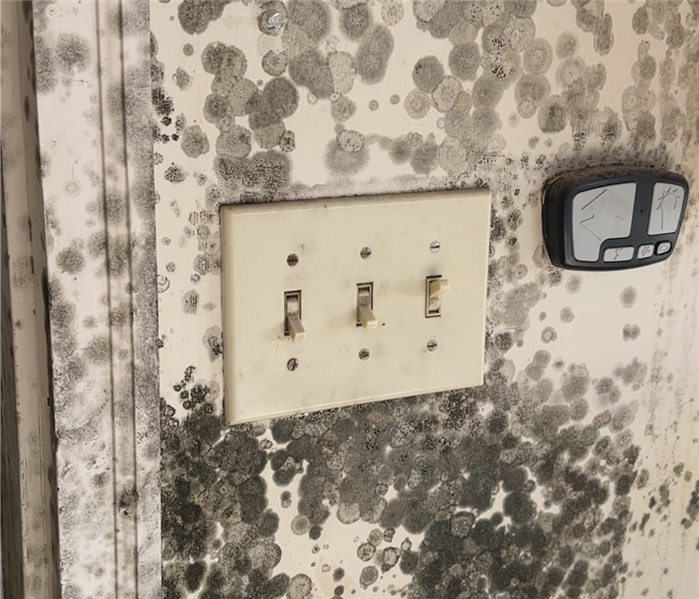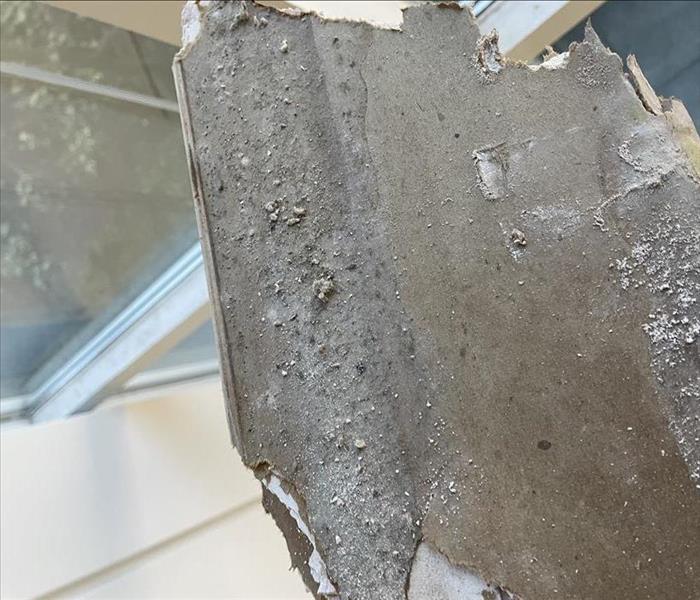What does black mold look like?
11/13/2024 (Permalink)
 Spotting black mold early can save you time and money on repairs.
Spotting black mold early can save you time and money on repairs.
When it comes to mold in your home, identifying it early is crucial for minimizing damage to your property. One of the most concerning types of mold is black mold, often found in areas prone to moisture. Knowing what black mold looks like can help you catch it early and take the necessary steps for remediation. In this guide, we’ll walk through the characteristics of black mold and how to spot it.
What Is Black Mold?
Black mold, scientifically known as Stachybotrys chartarum, is a common household mold that thrives in damp or water-damaged areas. It typically appears in dark, hidden places such as basements, bathrooms, or areas affected by water leaks. Unlike other molds, black mold has a distinctive appearance, making it easier to recognize if you know what to look for.
Key Characteristics of Black Mold
Black mold stands out because of its distinct look, which can vary slightly depending on its growth stage and the surface it inhabits. Here are some of the key traits to look for when identifying black mold:
- Color: True to its name, black mold is usually black or very dark green. Sometimes, it may appear with shades of brown or gray.
- Texture: Black mold often has a slimy or wet texture, especially when it’s actively growing. Over time, it can become dry and powdery.
- Shape: It typically grows in irregular patches or spots, and these areas may spread quickly if left untreated.
- Location: Black mold tends to grow in areas that have been wet for at least 48 hours, such as ceilings, walls, and floors near plumbing leaks.
Where to Look for Black Mold
According to a 2022 report from the Environmental Protection Agency (EPA), homes with water damage or high humidity are at the highest risk for black mold growth. Areas to inspect for black mold include:
- Bathrooms, especially around showers and bathtubs
- Kitchens, under sinks or around appliances that use water
- Basements and crawl spaces
- Attics with roof leaks
- Windowsills and door frames
How to Confirm It's Black Mold
If you suspect black mold but aren’t entirely sure, consider having a professional mold inspection. DIY mold test kits can be useful for basic identification, but they often miss hidden mold or fail to give a clear answer. A professional inspection can confirm the type of mold and help with the appropriate steps for removal.
Final Thoughts on Identifying Black Mold
Spotting black mold early can save you time and money on repairs. By regularly inspecting your home for the signs mentioned above, you can take immediate action before the issue worsens. If you think you have black mold, reach out to SERVPRO® of South Central Fort Worth for expert mold remediation services.
Mold Growth in Humid South Central Climates: Prevention and Remediation
9/11/2024 (Permalink)
 If the mold problem is extensive, it’s best to call in professionals like SERVPRO.
If the mold problem is extensive, it’s best to call in professionals like SERVPRO.
Living in the humid South Central climates comes with its unique challenges, and one of the most persistent issues homeowners face is mold growth. The high humidity levels in states like Texas, Louisiana, and Arkansas create an ideal environment for mold to thrive. As a SERVPRO® professional, I want to share essential tips on preventing mold growth and effective remediation techniques to help keep your home safe and clean.
Understanding Mold Growth
Mold spores are naturally present in the air, and they only need moisture, warmth, and a food source to grow. In humid climates, moisture is abundant, making mold a common problem. Mold can grow on various surfaces, including wood, drywall, carpet, and insulation, often resulting in unsightly stains and potential structural damage to your home.
Prevention Tips
The best defense is a good offense. To avoid a mold problem all together, consider using some of these prevention tips:
- Control Humidity Levels: Maintaining indoor humidity levels below 60% is crucial. Use dehumidifiers, especially in basements and crawl spaces, to reduce excess moisture. Air conditioners also help control humidity while keeping your home cool.
- Proper Ventilation: Ensure your home is well-ventilated. Use exhaust fans in bathrooms, kitchens, and laundry rooms to expel moisture-laden air. Opening windows and doors when the weather permits can also improve air circulation.
- Fix Leaks Promptly: Water leaks from pipes, roofs, and windows can lead to mold growth if not addressed immediately. Regularly inspect these areas and fix any leaks or water damage promptly.
- Use Mold-Resistant Products: When renovating or building, consider using mold-resistant drywall, paint, and insulation. These products are designed to withstand high moisture levels and can help prevent mold growth.
- Regular Cleaning and Maintenance: Clean and dry any damp or wet areas within 24 to 48 hours. Regularly clean gutters to prevent water from seeping into your home. Inspect your HVAC system for any signs of mold and ensure it is properly maintained.
Remediation Techniques
If you discover mold in your home, it’s essential to address it quickly and effectively. Here are some steps for mold remediation:
- Identify the Source: Determine the source of moisture and address it to prevent further mold growth. This may involve fixing leaks, improving ventilation, or using dehumidifiers.
- Contain the Mold: Isolate the affected area to prevent mold spores from spreading to other parts of your home. Use plastic sheeting to seal off the area and maintain negative air pressure if possible.
- Remove Moldy Materials: Remove and dispose of any mold-infested materials that cannot be cleaned, such as drywall, insulation, and carpeting. Seal these materials in plastic bags before disposing of them to prevent the spread of mold spores.
- Clean and Disinfect: Clean non-porous surfaces with a mixture of water and detergent. Use a stiff brush to scrub the mold off surfaces like concrete and tile. After cleaning, disinfect the area with a mold-killing solution.
- Dry the Area: Ensure the area is thoroughly dried to prevent mold from returning. Use fans, dehumidifiers, and proper ventilation to speed up the drying process.
- Prevent Future Mold Growth: After remediation, take steps to prevent future mold growth by controlling humidity, fixing leaks, and maintaining proper ventilation.
By following these prevention and remediation tips, you can protect your home from the damaging effects of mold. Remember, if the mold problem is extensive, it’s best to call in professionals like SERVPRO who have the expertise and equipment to handle mold remediation safely and effectively. Keep your home mold-free and enjoy the comfort of a clean living environment.
Revealing the Top 7 Hidden Places Mold Can Be Found in Your Home
7/17/2024 (Permalink)
 We uncover the top 7 hidden places where mold can be found in your home.
We uncover the top 7 hidden places where mold can be found in your home.
Mold is a common household problem that can lurk in various hidden places, often going unnoticed until it becomes a more significant issue. Identifying these hidden areas where mold can thrive is crucial for effective mold prevention and remediation. In this blog post, we'll uncover the top 7 hidden places where mold can be found in your home and provide tips for addressing and preventing mold growth in these areas.
Behind Walls and Wallpaper
Inside walls and behind wallpaper are ideal environments for mold growth, especially if there has been water damage or moisture intrusion. Mold can thrive in the dark, humid spaces between walls, making it challenging to detect until it spreads to visible surfaces.
Underneath Flooring
Mold can lurk underneath flooring materials such as carpet, laminate, or hardwood, particularly in areas prone to moisture, such as basements, bathrooms, and kitchens. Water leaks or spills can seep through flooring and create ideal conditions for mold growth beneath the surface.
Within HVAC Systems
HVAC systems provide the perfect breeding ground for mold, with dark, damp ductwork and evaporator coils providing ample moisture and organic material for mold spores to thrive. Mold growth within HVAC systems can spread mold spores throughout your home, leading to widespread contamination.
Inside Appliances
Appliances such as refrigerators, dishwashers, washing machines, and air conditioners can harbor mold growth if not properly maintained. Condensation, leaks, and food debris can create ideal conditions for mold to develop inside these appliances, often going unnoticed until the mold becomes visible or produces a musty odor.
Beneath Sinks and Cabinets
The space beneath sinks and cabinets is susceptible to mold growth, particularly in areas with plumbing leaks or poor ventilation. Damp conditions, combined with organic material from food waste or household cleaners, can create an ideal environment for mold to flourish in these hidden spaces.
Within Attics and Crawl Spaces
Attics and crawl spaces are often overlooked areas where mold can thrive. Poor ventilation, inadequate insulation, and roof leaks can create conditions conducive to mold growth in these hidden spaces. Mold in attics and crawl spaces can spread to other areas of the home if left unchecked.
Behind Appliances and Fixtures
Mold can hide behind appliances such as refrigerators, stoves, and washing machines, as well as fixtures like toilets and bathtubs. Condensation, leaks, and poor ventilation can create moist environments behind these appliances and fixtures, providing ideal conditions for mold growth.
Identifying and addressing hidden mold growth in your home is essential for maintaining a healthy indoor environment. By being aware of the top 7 hidden places where mold can be found and taking proactive measures to address moisture issues and improve ventilation, you can prevent mold from becoming a widespread problem in your home. If you suspect mold growth in any of these hidden areas, contact a professional restoration company like SERVPRO® for expert assessment and remediation services.



 24/7 Emergency Service
24/7 Emergency Service


